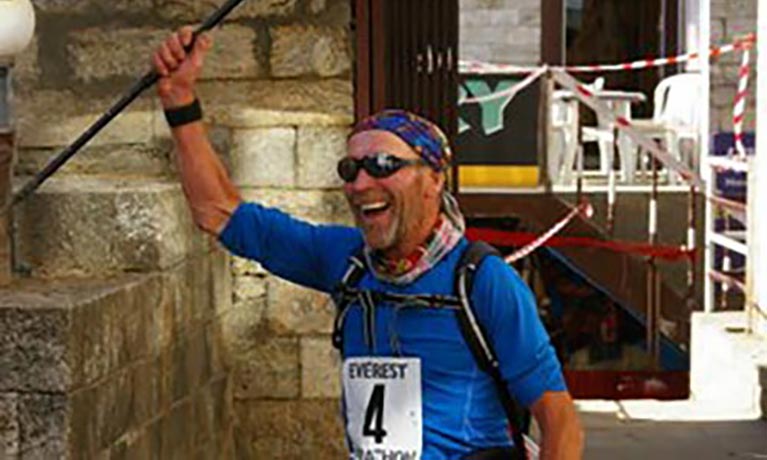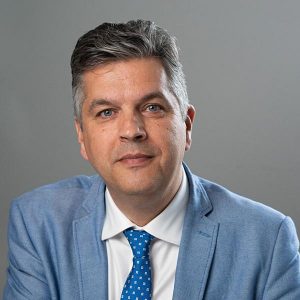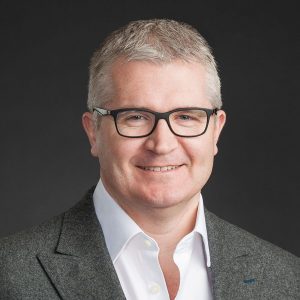Peter is cycling daily, back to his physically demanding work and is delighted with his recovery following his osteotomy with Dr Ronald van Heerwaarden and Mr Raghbir Khakha
Peter is exclusively a mountain runner at all distances up to 42k (marathon distance).

As soon as I met Prof Wilson and asked all the questions I had I could see here was a super-specialist in his field. I’m quite well educated on sports medicine through research and study I do as a hobby, and it was very clear that I had found my man! His technical expertise was really reassuring. All that mattered to me was to be able to get back to running and it was a no brainer to have the osteotomy operation.
TAGGED INDr Ronald van HeerwaardenMr Raghbir KhakhaProf Adrian Wilson
Knee osteotomy (realignment) surgery
The London Knee Osteotomy Centre
Mr Ronald van Heerwaarden and Mr Raghbir Khakha perform complex osteotomy surgery and bone grafting for Peter
Peter is exclusively a mountain runner at all distances up to 42k (marathon distance). The marathons have included the North Pole, Antarctic ice marathon, Swiss Alpine, Everest marathon from base camp, Kilimanjaro, Inca Trail and Pikes marathon. Of these he had 4 top ten finishes despite his age (65), all being completed after hip resurfacing 11 years ago. Peter explains: “I mostly run hill sprints and run in the world masters with Ireland team. My best performance was 12th place running to summit of Pikes Peak at 14,250 feet high. I mostly train up to 10k and at all times train smart and listen to my body. I also cross train with cycling, wind surfing and surfing.”
Peter has medial compartmental osteoarthritis, i.e. arthritis on the inner side of the knee. He was previously been treated with an Atlas device, which is an implantable joint unloader that works like a shock absorber for your knee, which had been removed at a later date.
Following extensive online research Peter sought treatment with Professor Adrian Wilson initially due to his expertise in osteotomy surgery as he was clearly the UK’s leading expert. Osteotomy surgery restores the normal alignment of the knee, removing pressure on the arthritic or injured area of the knee as a result. An osteotomy can usually significantly delay the need for knee replacement surgery, and in many instances, remove the need for a knee replacement altogether.
Whilst Peter had a limited amount of medial knee pain and remained fit and active, he was keen to preserve his knee for as long as possible and thought Professor Wilson would be the best person to advise him. Professor Wilson’s expertise in developing minimally invasive osteotomy and the team he leads at The London Osteotomy Centre meant Peter knew he would be speaking to super-specialist surgeons. He realised that at some point, either next week, next month or perhaps in a few years, he would develop more knee pain due to the osteoarthritis. Peter explains: “I didn’t want a partial knee replacement as I wanted to still be able to compete. You only have one life and quality of life was paramount as far as the decision to have the osteotomy operation.”
After meeting Professor Wilson Peter knew he was in safe hands: “As soon as I met Prof Wilson and asked all the questions I had I could see here was a super-specialist in his field. I’m quite well educated on sports medicine through research and study I do as a hobby, and it was very clear that I had found my man! His technical expertise was really reassuring. All that mattered to me was to be able to get back to running and it was a no brainer to have the osteotomy operation.”
Professor Wilson suggested that Peter have a consultation with Dr Ronald van Heerwaarden to decide on which type of osteotomy would be suitable for Peter – a medial opening wedge, a lateral femoral closing wedge or a lateral closing wedge tibia for correction of varus. Dr van Heerwaarden is a globally renowned authority in knee osteotomy and one of the few surgeons worldwide to have dedicated his entire practice to joint preservation.
After further discussion with Dr van Heerwaarden, Peter was totally reassured, he says: “What a surgeon! He made me feel totally relaxed, he listened and answered all my questions – there were many! He also tells it as it is in a very straightforward way, so I knew exactly what was going to happen.”
The surgery would be carried out by Dr van Heerwaarden and Mr Raghbir Khakha, a fellowship trained specialist trauma and orthopaedic knee surgeon and colleague of Professor Wilson and Dr Heerwaarden at the London Knee Osteotomy Centre.
After discussion and reviewing his X-rays, the team confirmed that a medial open wedge high tibial osteotomy would be the treatment of choice for Peter. They also identified a bony spur in Peter’s knee which was catching on the inside of the knee, which would be removed under X-ray guidance during the same operation.
Peter met Mr Khakha on the morning of surgery, he says: “Mr Khakha was so enthusiastic and so fresh! He is clearly another skilled surgeon and I liked the way he was so clear and precise about everything that was going to happen.”
The osteotomy was very straightforward, and Peter was off his crutches very quickly and has had very little pain since the surgery. He is amazed by his recovery and this is testament to the surgical techniques that Mr van Heerwaarden performed and the use of anaesthetics to manage pain relief. The use of cryotherapy device Physiolab® post operatively makes a huge difference to patients such as Peter’s recovery from surgery.
Peter’s operation took place on 19th December and by the day after Boxing Day he was out cleaning his drive, whilst continuing to use the Physiolab® device.
Here is Peter catching up with Dr van Heerwaarden in outpatients six weeks after surgery. He has a fantastic range of motion and a beautifully straight knee. He is cycling 12 miles every other day and he’s over the moon.
The following week Peter was back at work, installing a big conservatory roof on his first day and another roof the second day. Peter says: “I’ve been up and down ladders for 2 days with no pain at all, despite reduced muscle strength.”
He sums up his treatment with Professor Wilson, Mr van Heerwaarden and Mr Khakha: “It couldn’t have been a better experience and fulfilled all my expectations. I had confidence in the entire team throughout the process. I travelled to London from Northern Ireland for this treatment, but it was well worth it.” He continues: “With the HTO (high tibial osteotomy) I have just had it is important to respect the fact that there is arthritis still present in the joint and I firmly believe that sometimes less is more. Thus, I do highly intensive shorter distances as opposed to long hard slogs which I feel will shorten my running career. This HTO was a good experience for me and I am still miffed at how speedy my recovery has been after 4 weeks. I was up and out in the garden and in our business workshop after the 1-week time scale but religiously elevating and Physiolab every 2 hours or so. I am back fully at work installing conservatories and roofs at 6 weeks, so yes delighted.”
He finishes: “This weekend I’m going to try walking a hilly 5-mile circuit as well as the bike ride!”
Mr van Heerwaarden said: “I am delighted Peter is doing so well after his surgery. His quick recovery and very fast rehabilitation confirm what we know from experience and what we have described in our scientific publications. In two large studies of almost 300 of our patients published recently [1,2] we found that 95% return to work and 9 out of 10 patients return within 6 months. Furthermore, 82% of our high tibial osteotomy patients return to sports of which 75% within 6 months. Mr Bell is exceptionally fast in his progress and as the specific osteotomy plates we use for fixation can withstand high loads immediately, he is allowed to return to his beloved mountain running already at 6 weeks postoperative.”
Mr van Heerwaarden said: “I am delighted Peter is doing so well after his surgery. His quick recovery and very fast rehabilitation confirm what we know from experience and what we have described in our scientific publications. In two large studies of almost 300 of our patients published recently [1,2] we found that 95% return to work and 9 out of 10 patients return within 6 months. Furthermore, 82% of our high tibial osteotomy patients return to sports of which 75% within 6 months. Mr Bell is exceptionally fast in his progress and as the specific osteotomy plates we use for fixation can withstand high loads immediately, he is allowed to return to his beloved mountain running already at 6 weeks postoperative.”
Peter gives an update in March 2021 on how he has progressed since the osteotomy, his plate removal and his more recent BMAC (Bone Marrow Aspirate Concentrate) treatment: “By November 2020 when I was due for the plate removal after the osteotomy, I was pretty much up to par in terms of work and sport. This normally involves an hour and a half on a mountain bike on a hilly course, an 8-9km mountain run and a sea swim every Saturday. I do an additional 25-30 miles on a gravel bike after work on Tuesdays and Thursdays. I understand the mechanics of the knee so train smart – I know what I can and can’t do on my knee. I was finding that towards the end of an 8km run, whilst I had no pain, I was starting to get a bit of aching at the back of the knee, which I thought could be due to more arthritis. It was therefore recommended that I have BMAC at the same time as the plate removal. So far this has been a good procedure. It has further improved the function in my knee, I have no restrictions in the range of movement, and it is almost as good as my other knee which has no arthritis. It had already improved massively after the HTO as I was previously struggling with flexion and can now extend it as much as the other knee. My knee function is better, and I am now able to run same course at the same speed with the same reaction as before and it recovers more quickly on a daily basis. I regularly use a portable cryotherapy device as a preventative measure. After the BMAC procedure I was recommended not to run for 90 days, I just walked and did some power walks. I wanted it to fully heal before I got back to running. Since then, I have progressed to getting pretty close to an elite level in mountain running for my age. I have regularly run in The World Masters Mountain Running Championships, which are held all over the world. My best performance was coming 12th for my age group in Colorado a few years ago. If my running progresses between now and the Masters this September I will have a place under team Ireland.”


Looking to speak to our team? Call us on 020 7046 8000 020 7046 8085
To book an appointment
or refer a patient







